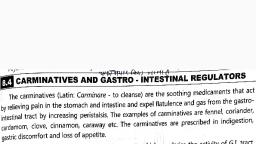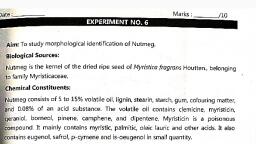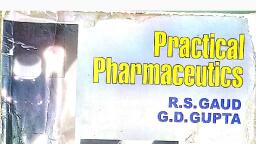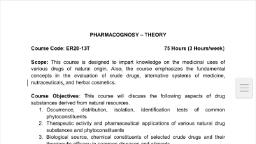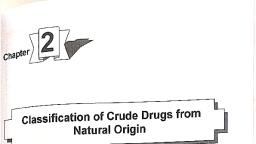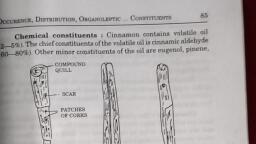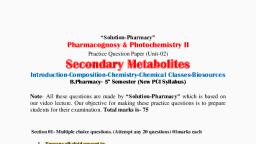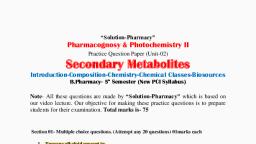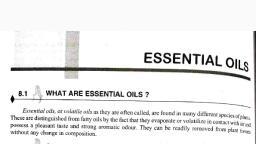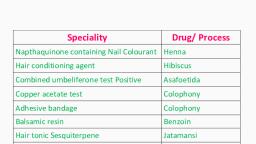Page 2 :
❖ Carminative: Carminatives are the drugs that expel gases from, the gastrointestinal tract by increasing peristalsis ., These are the drugs taken in indigestion, gastric discomfort and loss, of appetite., ❖ Gastrointestinal regulators: Gastrointestinal regulators are, agents that regularize the activity of gastrointestinal tract., These are used as bitter stomachic, appetizer, antiemetic,, stimulants and aromatics., ❖Drugs : Coriander, Fennel, Ajowan (Umbelliferous), Cinnamon,, Cardamom, Clove, Asafoetida, Ginger, black-pepper,, Nutmegtract by increasing peristalsis .
Page 3 :
Synonyms : Heeng, Hing, Hingu, Devil’s dung , Gum asafoetida, Biological source: It is the oleo-gum-resin obtained by making, incision to the living rhizomes and roots of Ferula foetida, Ferula, asafoetida, Family : Umbelliferae (mostly aromatic plants with hollow stems), [The Umbelliferae family is named after the shape of its flowers,, which are called umbels. These distinctive umbrella shaped blooms, are attractive in arrangements and loved by numerous beneficial, insects], Geographical distribution: India(Kashmir), Distributed from, Mediterranean region to central Asia specifically Persia &, Afghanistan.
Page 5 :
Characteristics:, Size: 0.5- 2 cm in diameter in tear form., Shape: oval/round and in lump form: size varies and, shape is irregular, Colour: Greyish-white or reddish, Fracture: Granular, Odour: Nauseating, Taste: Bitter & Acrid
Page 6 :
CHEMICAL TESTS:, 1. Powder triturated with water – yellowish orange emulsion is, produced., 2. Combined umbelliferone test – Drug is boiled with hydrochloric acid, for 5minutes. It is filtered and ammonia is added to the filtrate – A, blue fluorescence is produced ., 3. Drug is treated with few drops of 50% nitric acid – Green colour is, produced, 4. Drug is treated with few drops of sulphuric acid – red colour is, produced which changes to violet on washing with water., 5.Alcoholic extract, When treated with phloroglucinol and Conc.HCL,, gives pink colour., 6.Alcoholic solution of asafoetida treated with alcoholic solution of, ferric chloride , gives brownish precipitate., 7.Aqueous emulsion of Asafoetida , when treated with KOH solution,, produces dark red color due to phenolic substance asaresinol., 8. On burning asafoetida gives a yellow flame.
Page 7 :
Uses :, 1. It is use as a carminative and expectorant., 2. It is use as an antispasmodic & laxative., 3.It is use as a nervine tonic., 4. Use in enema for intestinal flatulence in diseases like, Cholera, Asthma, whooping cough & chronic bronchitis., Adulterants:, , 1.Ammonicum, 2.Gum Arabic, 3.Red clay, 4.Chalk
Page 8 :
Sr.No, , Adulterants:, , 1, , Ammonicum, , 2, , Gum Arabic, , 3, , Red clay, , 4, , Chalk, , Image
Page 11 :
Mace:, The arilus of the seed of nutmeg is called mace. Mace, contains about 20% fixed oil & 25.1% volatile oil. Mace, is used as condiment and flavoring agent. It is used as, aromatic and carminative.
Page 12 :
✓Synonym: Grains of paradise, Cardamom fruit, ✓Biological source: It consist of dried ripe Fruit/ seeds of Elettaria, cardamomum, ✓Family : Zingiberaceae, ✓Geographical source: Cultivated in India in Karnataka, Mysore, and Malabar hills: Sri Lanka, Thailand &, Tanzania.
Page 13 :
Morphology: Cardamom fruit is a three –sided capsule with a fibrous, papery, and longitudinal wrinkled pericarp. In each cell, two rows of seeds are present, on an adherent mass attached to an axile planceta., Fruit:, Seed:, Size: 8-15 mm long :, Size: 4 mm long: 2-3 mm broad, Shape: Oblong Ovoid : Shape: Irregularly angular, usually tapering to the base, Colour: Green to pale buff : Colour: Dark reddish -brown, Odour: Strong & Aromatic : Odour : Strong & Aromatic, Apex: Shortly beaked, ❖, , ❖Chemical constituents:, 1.Volatile oil- Cineol (Eucalyptol), terpineol, borneol, terpinene, 2.Fixed oil-in seed : contain glycosides of oleic, steraic and caproic acid, 3.Protein, 4.Aromatic, Stimulant, 5.Flavouring agent
Page 14 :
, 1., , Adulterant/substituent:, Long wild native cardamomum: These are longer and, more elongated, pericarp is dark grayish in colour, seed, have bitter taste and less aromatic., , 2. Korarima cardamomum: Reddish-brown in color, 3. Loose seeds/ fully ripe seeds:, less volatile oil content., 4. Cardamom husk: Husk can be detected from the authentic, drug by presence of more ash content.
Page 15 :
✓Synonym: Kali-miri, ✓Biological source: It consist of Unripe fruits perennial climbing vine Piper, nigrum, ✓Family : Piperaceace, ✓Geographical source: Cultivated in India in Karnataka,Mysore and, Malabar hills: Sri Lanka, Thailand & Tanzania.
Page 17 :
❖, , Uses:, , 1.stimulant, carminative, aromatic, stomachic, 2.It causes feeling of warmth & use as condiment., , 3. It stimulates taste buds, with increase in gastric juice., 4.The oil is mainly use as spice due to pungent taste., 5. The health benefits of black pepper include relief from respiratory disorders,, coughs, the common cold, constipation, indigestion, anemia, impotency,, muscular strains, dental disease, pyorrhea, diarrhea, and heart disease, Substitute:, 1.Piper attenuatum : found in vishakhapattanam (Tamilnadu & Madurai), 2.Piper brachystachyum: found in Tirunelveli &Nilgiri districts of, Tamilnadu, 3.Piper longum : available in Tamilnadu, Andhra Pradesh & Kerala Known as, PALMAL , important substitute of official drug
Page 18 :
❖ Synonym: Zinziber, Zingiberis, Ale, Adrakam, ❖ Biological source – It consists of the dried scraped or unscrapped rhizomes, of Zingiber officinalae, ❖ Family – Zingiberaceae, ❖Geographical distribution: Native to South-East Asia,Cultivated in, Africa,Jaimica and India., ❖ Morphology:, Size: 5-15 cm long, 3-4 cm wide, Shape: Rhizomes having branches with bud at the apex., Colour: Buff, Odour: Agreeable & Aromatic, Taste: Pungent
Page 21 :
Microscopy of Ginger:
Page 22 :
1) Cork:, Outer cork: Few layers, dark brown colored irregularly arranged, parenchymatous cells., Inner cork: Few layers, colored parenchymatous cells, radially arranged in, regular rows., 2) Cortex: Isodiametric, thin walled parenchymatous cells, with scattered, vascular strands and numerous idioblasts about 40 to 80 µ in diameter., Yellowish to reddish brown oleoresin is present in OLEORESIN, Cells.Starch grains present in parenchymatous cells., Fibro vascular bundles:, Vascular bundle is collateral, conjoint and closed .a group of, sclerenchymatous fibers partially covers the vascular bundles of cortex, and ground tissue region., Xylem vessels:, Tracheids with annular , spiral or reticulate thickening .No reaction for, lignin.
Page 23 :
3) Endodermis:, Single layered , radial walls slightly thickened , free from starch., , 4) Ground tissue: Large parenchymatous cells with abundant starch,, oleo-resin cells and vascular bundles., Vascular bundles: Ring of vascular bundles below endodermis, narrow, zone not covered with sclerenchymatous fibers, Starch: Flattened, rectangular ovate grains with the hilum in terminal, projection. Mostly 5 to 15 to 30 to 60 µ long, 25 µ wide, 7 µthick,, marked by transverse striations.
Page 24 :
1. Schizocarp (splitting fruits)- Dry fruits from syncarpus, ovary that splits at maturity into 2 portions.( the female, reproductive organ of a flower, consisting of an ovary, a, stigma, and usually a style. It may occur singly or as one, of a group.), 2. Mericarp- Each portion of Schizocarp (cremocarp) is, called as mericarp., 3. Two mercers join together by a thread like structure, called as carpophore., 4. Primary ridges are 5 or more runs from apex to base., 5. Each mericarp has a disc like structure at the apex, called as stylopod., 6. Each mericarp has 2 surfaces, a) Outer dorsal or curved surface, b) Inner ventral or commissural surface., 7. Each mericarp contains 6 vittae- 4 on dorsal surface, and 2 on commissural surface., 8. Each mericarp contains a single seed. The seed, contains1. An apex, 2. Endosperm, 9. All umbelliferous fruits contains Volatile oil.
Page 26 :
Synonym: Misreya, Sauf, Variyali, Badishep, Biological source – It consists of the dried ripe fruits of Foeniculum, vulgare, Family – Umbelliferae, Geological source:, The plant widely cultivated in many parts of Europe, china, Russia,, Egypt and India. In India, it is commonly cultivated throughout the, country and often grows wild., Morphology:, Fruit:, Size: 5-10 mm length, 2-4 mm width, Shape: Broadly ovate, Colour: Yellowish brown, Odour: Sweet, Aromatic
Page 27 :
Chemical constituents:, Voaltile oil- Anethole (Phenolic ether) & Fenchone (Ketone) giving fruit a, distinct odor and taste. Methyl carvacrol anisaldehyde, α-pinene, limonene,, phellandrene., Fixed oil, Uses:, 1) Stimulant, aromatic, stomachic, carminative and expectorant., 2) Anethole is use in mouth and dental preparation., 3) Use in diseases of the chest, spleen and kidney., 4) Fennel fruit used as condiment., 5) Volatile oil, hydro distilled from fennel , is used in pharmaceutical and, food industry., Adulterant:, Adulteration of fennel fruit is done by mixing exhausted fruits with normal, fruits. Exhausted fruits of Fennel, a) Contain less volatile oil, b) Are darker in colour, c) Sink at once in water
Page 30 :
1) Epiacrp:, It is made up of quadrangular to polygonal cells with smooth cuticle., 2) Mesocarp:, Mesocarp consists of thick reticulate lignified parenchyma, which surrounds, the vascular bundles in the region of primary ridges. Rest of the mesocarpic, parenchyma is made up of polygonal tissues. Five bicolateral vascular, bundles are present, each below the primary ridge., Four vittae (Schizogenous oil cells) are present on dorsal side and two on the, ventral (commissural) surface., 3) Endocarp:, Endocarp consist of inner epidermis, testa and narrow parquetry layer The, endosperm is parencymatous with abundant grains., Raphe is single ridge of vascular strands which appears in the middle of, commissural surface., Carpophores: Thick-walled sclerenchyma in two stands.
Page 32 :
Uses:, , 1. Stimulant, Carminative, Aromatic,, Stomachic, 2.Diuretic & tonic, 3.Ointment is use in treatment of rheumatic, disease, 4.Flavouring agent, 5. Linalool in preparation of perfume
Page 35 :
1) Epiacrp:, It is made up of quadrangular to polygonal cells with smooth cuticle., 2) Mesocarp:, Mesocarp consists of thick reticulate lignified parenchyma, which surrounds, the vascular bundles in the region of primary ridges. Rest of the mesocarpic, parenchyma is made up of polygonal tissues. Five bicolateral vascular, bundles are present, each below the primary ridge., Four vittae (Schizogenous oil cells) are present on dorsal side and two on the, ventral (commissural) surface., 3) Endocarp:, Endocarp consist of inner epidermis, testa and narrow parquetry layer The, endosperm is parencymatous with abundant grains., Raphe is single ridge of vascular strands which appears in the middle of, commissural surface., Carpophores: Thick-walled sclerenchyma in two stands.
Page 37 :
Chemical constituents:, 1) Voaltile oil- Thymol, p-cymene, terpinene,, Ajowan oil is brownish –yellow liquid possessing a characteristic odor of, thymol and sharp taste., 2) Fats, 3) Proteins, 4) Carbohydrates, Uses:, 1) Stimulant, anti-spasmodic, carminative., 2) It is use in case of bronchitis and cough., 2) Externally crushed fruit is applied in relief of colic pains., 3) Ajowan oil is used as antiseptic, antifungal, insecticide and anthelmintic., 4) It is used as deodorant in mouth washes, tooth paste and gargles and as, aromatic agent in disinfectants and soaps.
Page 38 :
➢Synonym: Kalmi -dalchini, Ceylon cinnamon, Twak, ➢Biological source: It consist of dried inner bark of coppiced shoots of, Cinnamomum zeylanicum, ➢Family: Lauraceae, ➢History: Word cinnamon is obtained from Arabic word Cinnamon, which, means “ sweet wood”, Morphology: BARK, Size: 1 mm length, 6 mm width, Shape: Compound quill, Color: Yellowish brown outer surface & dark inner surface, Odor: Fragrant, delicate and aromatic, Taste: Aromatic, Sweet followed by warming sensation, Fracture: Splintery
Page 41 :
Microscopy:, 1), , 2), i), ii), , Complete absence of epidermis , cork cells and underlying cortical parenchyma., , Pericycle- stone cell layer, Pericyclic fibers: Small groups of ix to fifteen pericyclic fibers, which are lignified ,, occur at interval., Sclerides: Three to four layers of pitted sclerides which are thickened lignified are, present in the outer layer. It contains mucilage cells., , 3), , Phloem zone: The primary phloem is indistinguishable. The secondary phloem consists, of parenchyma cells containing oil and mucilage cells. Phloem fibers are either isolated, or in a group of two to five. They are more abundant towards the inner part of the bark., Phloem fibers are 12-22 m wide, , 3), , Medullary rays: The medullary rays are uniseriate or biseriate and widen as they, approach the pericycle. Numerous acicular crystals of calcium oxalate are scattered, throughout the bark. The oil cells secreting volatile oil and mucilage cells are found in, this zone. A starch grain 5-10 m in diameter is present throughout the section.
Page 42 :
Chemical test:, , 1), , Add 5 ml of alcohol to volatile oil and a drop of ferric chloride, Green color is produced, due to cinnamon aldehyde and eugenol., , 2) Take chloroform extract of oil or oil on slide , to it add drop of 10 % aqueous phenyl, hydrogen hydrochloride solution, Rod shaped crystals of cinnamon aldehyde will be, observed., 3) Aq.extract of cinnamon treated with 5% ferric chloride solution, shows dark coloration,, due to presence of tannins., 4) When aq. Extract is treated with lead acetate reagent , white precipitate is obtained due to, presence of tannins., 5) Treat the aqueous extract with potassium permanganate solution. Decolourization takes, place due to presence of tannins.
Page 43 :
➢Synonym: Clove flower, Clove bud, Caryophyllum, ➢Biological source: It consist of dried flowers buds of Eugenia caryophyllus, ➢Family: Myrtaceae, ➢History: Word Eugenia is obtained from Latin word and caryophyllus is, Greek word means nut-leaf, which refers to nut like flower bud,, Clove is from Latin word Clavus meaning a nail, which refers to the shape of the, whole spice., Morphology: FLOWER BUD, Size: 10-17 mm long, Shape: Sub-cylindrical slightly flattened, Color: Dark brown, Taste: Aromatic, Pungent followed by numbness of the tongue.
Page 46 :
Substitute:, 1), Exhausted clove: In this drug, volatile oil is partially / entirely, removed by distillation so contains less volatile oil. Exhausted, cloves are dark in colour, more shrunken and float on water., 2), Clove stalks: Clove stalks contain only 5% volatile oil.Clove, stalks can be detected as it contains thick walled pitted stone, cells. Prism of calcium oxalate and small starch grains and, reticulate vessels., 3), Mother clove/ clove fruits: These are ripe fruits of clove, which, are ovoid, brown drupe one seeded. Mother cloves contain less, volatile oil, the presence of which can be detected by the starch, present in the seed even in powdered form., 4), Blown cloves: are fully expanded flowers which usually corolla, and stamens get detached. They contaion less volatile oil as, compared to clove buds.





